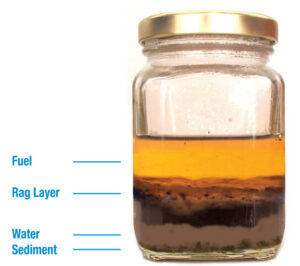Fuel Treatment
What is microbial growth or bugs? How do bugs grow? Find out the warning signs and learn how Penray’s Fuel Doctor Program can help you schedule service, collect samples and recommend treatments to maintain healthy diesel fuel year-round.
Microbial Growth
Microbial growth – or bugs – is a very serious problem. It starts with water, and there is always some amount of water in diesel fuel storage systems. It comes from various sources, such as;
- vapor recovery, which introduces water vapor into the fuel (as part of the Clean Air Act),
- condensation that occurs due to temperature changes in the fuel storage tank, and
- the process to create ULSD, which uses water, and from which some residual moisture remains.
Microorganisms naturally occur in water. Water is the perfect habitat for these bugs to thrive. Once the fuel is placed into a storage tank and sits idle, the water separates from the fuel. Without proper treatment, the bugs begin to grow and deteriorate the fuel leading to several problems outlined below.

How do the bugs grow?
Because there is water and a food source — the diesel fuel — storage tanks are a perfect breeding ground for microorganisms (bugs). The bugs have an abundant food supply, feeding off the hydrocarbons in the fuel. The “rag layer” indicated below is the emulsion of water and fuel supporting the growth of the bugs. Once the bugs begin to grow, they double in population every 20 minutes. As the bugs multiply, they produce waste products, which, in turn. create sludge, acids and other harmful by-products impacting the fuel and the storage tank. Eventually a black, brown or green slime will form clogging filters, corroding metal and causing hoses to swell and blister.
Warning Signs
Does my fuel storage system have Bugs?
 To determine if the fuel storage system has bugs a sample of the fuel needs to be pulled from the bottom of the tank. Typically, this is performed using a device called a Bacon Bomb or fuel thief, as shown. The sampling device should be properly cleaned prior to collecting the tank sample to avoid cross contamination of the sample.
To determine if the fuel storage system has bugs a sample of the fuel needs to be pulled from the bottom of the tank. Typically, this is performed using a device called a Bacon Bomb or fuel thief, as shown. The sampling device should be properly cleaned prior to collecting the tank sample to avoid cross contamination of the sample.
Some of the fuel will be used for the Microbial Cult test and the remaining fuel may be used to perform cold filter plug point, pour point and cloud point tests. Contact your Penray Fuel Doctor to explain the process and schedule a fuel sampling appointment.
Other Symptoms and Signs:
In addition to the fuel sample analysis, several symptoms may indicate a problem. Examples include slow flow rate from the dispenser, clogged dispenser filters, sulfurous odor (rotten-egg), leopard type spotting on a fuel filter and slime coating on metal parts or blistered hoses. If any of these symptoms are present the fuel storage system is no longer healthy and requires immediate attention.
How are the bugs killed?
Biocides are regulated and registered by the EPA. Biocides are designed to kill and control bacteria, fungus and mold in fuel. They only address problems with living organisms in the fuel storage system, biocides do not address problems associated with oxidation that lead to sediment and gum. Penray carries ValvTect® Bioguard® Microbiocide, an EPA registered biocide which is used to kill and control bugs in the fuel storage system. ValvTect® Bioguard® Microbiocide works quickly in as little as 2-3 hours. The dead bugs will fall to the bottom of the storage tank and should be removed with the water to prevent additional fuel filter clogging. To prevent the growth of new bugs, regular treatment with ValvTect® Bioguard® Microbiocide several times a year and regular checking and removal of water is recommended.
Fuel Doctor Program
How to Maintain Healthy Fuel
Why is it important?
- Untreated fuel leads to significant problems in storage tanks including separation, tank corrosion, oxidation, sludge, microbial growth and sediment.
- The impact is clogged fuel filters, expensive clean out costs, leaking storage tanks, premature tank replacement and unhappy customers.
- These issues can be very difficult to detect and require routine testing and tank maintenance.
- The Penray Fuel Doctor plan ensures your fuel and storage tanks are at optimum health.
Fuel Doctor Tri-Fold Brochure
ValveTect BioGuard Microbiocide Flyer.
When should I test?
Penray recommends testing twice yearly:
- Spring: test for microbial activity
- Fall: test for cold weather properties and microbiological activity
Typical warning signs of fuel issues include:
- Slow flow rate
- Clogged filters
- Sulfurous odor
- Slime coating on metal parts
- Blistered hoses
Any of these symptoms require immediate attention.
How can I get started?
- Contact your regional Fuel Doctor or call Penray at Ph. 800.373.6729.
- Schedule a fuel check-up.
- A Penray Fuel Dr. will visit your site to collect samples for analysis.
- Results will be available within 3 days.
- Your Penray Fuel Dr. will discuss the results, recommend treatment and ensure your fuel is healthy!
TYPICAL QUESTIONS:
QUESTION : IF WATER IS IN THE TANK, HOW DO I REMOVE IT?
ANSWER : Penray is partnered with Allied Oil who specializes in storage tank water removal and fuel cleaning. See flyer link below for details.Tank Cleaning Flyer
QUESTION : MY FUEL TESTED FINE, DO I STILL NEED TO ADD A FUEL TREATMENT?
ANSWER : Yes, in order to maintain healthy fuel, a fuel additive should be used every time there is a new fuel drop to prevent problems from occurring.

